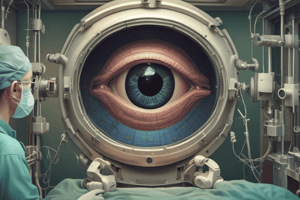Podcast
Questions and Answers
What is the primary mechanism of action of general anesthesia?
What is the primary mechanism of action of general anesthesia?
- Induces a state of relaxation and reduced anxiety
- Numbs a small area of the body
- Acts on the brain and spinal cord to disrupt neural transmission and consciousness (correct)
- Blocks nerve conduction in a specific region
What type of anesthesia induces unconsciousness and loss of sensation?
What type of anesthesia induces unconsciousness and loss of sensation?
- Local anesthesia
- Conscious sedation
- Regional anesthesia
- General anesthesia (correct)
Which of the following is an example of an inhaled anesthetic?
Which of the following is an example of an inhaled anesthetic?
- Bupivacaine
- Lidocaine
- Sevoflurane (correct)
- Propofol
What is the purpose of pulse oximetry in anesthesia monitoring?
What is the purpose of pulse oximetry in anesthesia monitoring?
What is the stage of anesthesia characterized by loss of consciousness and muscle relaxation?
What is the stage of anesthesia characterized by loss of consciousness and muscle relaxation?
Who is responsible for anesthesia care in the operating room?
Who is responsible for anesthesia care in the operating room?
What is a potential complication of anesthesia?
What is a potential complication of anesthesia?
What is the purpose of end-tidal CO2 monitoring in anesthesia?
What is the purpose of end-tidal CO2 monitoring in anesthesia?
Flashcards are hidden until you start studying
Study Notes
Definition and Types
- Anesthesia: a state of controlled, temporary loss of sensation or awareness, induced for medical or surgical purposes
- Types:
- General anesthesia: induces unconsciousness and loss of sensation
- Regional anesthesia: numbs a specific region of the body (e.g., spinal, epidural)
- Local anesthesia: numbs a small area of the body (e.g., topical, infiltrative)
- Conscious sedation: induces a state of relaxation and reduced anxiety
Mechanisms of Action
- General anesthesia: acts on the brain and spinal cord to disrupt neural transmission and consciousness
- Regional anesthesia: blocks nerve conduction in a specific region
- Local anesthesia: blocks nerve conduction in a small area
- Conscious sedation: acts on the brain to reduce anxiety and promote relaxation
Anesthetic Agents
- Inhaled anesthetics: e.g., halothane, sevoflurane, isoflurane
- Intravenous anesthetics: e.g., propofol, etomidate, ketamine
- Local anesthetics: e.g., lidocaine, bupivacaine, novocaine
Stages of Anesthesia
- Stage 1: analgesia (pain relief)
- Stage 2: delirium (disorientation and excitement)
- Stage 3: surgical anesthesia (loss of consciousness and muscle relaxation)
- Stage 4: respiratory arrest (rare and potentially life-threatening)
Anesthesia Risks and Complications
- Respiratory depression
- Cardiac complications
- Allergic reactions
- Nerve damage
- Post-anesthesia care unit (PACU) complications
Anesthesia Monitoring
- Electrocardiogram (ECG)
- Blood pressure monitoring
- Pulse oximetry
- End-tidal CO2 monitoring
- Anesthesia depth monitoring (e.g., bispectral index)
Anesthesia Team
- Anesthesiologist: medical doctor responsible for anesthesia care
- Certified registered nurse anesthetist (CRNA): advanced practice nurse responsible for anesthesia care
- Anesthesia technician: assists with anesthesia equipment and supplies
Definition and Types of Anesthesia
- Anesthesia is a controlled, temporary loss of sensation or awareness induced for medical or surgical purposes
- Four types of anesthesia: general, regional, local, and conscious sedation
General Anesthesia
- Induces unconsciousness and loss of sensation
- Acts on the brain and spinal cord to disrupt neural transmission and consciousness
Regional Anesthesia
- Numbs a specific region of the body (e.g., spinal, epidural)
- Blocks nerve conduction in a specific region
Local Anesthesia
- Numbs a small area of the body (e.g., topical, infiltrative)
- Blocks nerve conduction in a small area
Conscious Sedation
- Induces a state of relaxation and reduced anxiety
- Acts on the brain to reduce anxiety and promote relaxation
Anesthetic Agents
- Inhaled anesthetics: halothane, sevoflurane, isoflurane
- Intravenous anesthetics: propofol, etomidate, ketamine
- Local anesthetics: lidocaine, bupivacaine, novocaine
Stages of Anesthesia
- Stage 1: analgesia (pain relief)
- Stage 2: delirium (disorientation and excitement)
- Stage 3: surgical anesthesia (loss of consciousness and muscle relaxation)
- Stage 4: respiratory arrest (rare and potentially life-threatening)
Anesthesia Risks and Complications
- Respiratory depression: a potential life-threatening complication
- Cardiac complications: arrhythmias, hypotension, and hypertension
- Allergic reactions: to anesthetic agents or latex
- Nerve damage: peripheral nerve damage or spinal cord injury
- Post-anesthesia care unit (PACU) complications: respiratory, cardiac, and bleeding complications
Anesthesia Monitoring
- Electrocardiogram (ECG): monitors cardiac activity
- Blood pressure monitoring: monitors hypertension and hypotension
- Pulse oximetry: monitors oxygen saturation
- End-tidal CO2 monitoring: monitors respiratory function
- Anesthesia depth monitoring: monitors depth of anesthesia using bispectral index
Anesthesia Team
- Anesthesiologist: medical doctor responsible for anesthesia care
- Certified registered nurse anesthetist (CRNA): advanced practice nurse responsible for anesthesia care
- Anesthesia technician: assists with anesthesia equipment and supplies
Studying That Suits You
Use AI to generate personalized quizzes and flashcards to suit your learning preferences.




